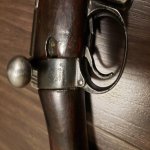1945 GRI no1 wire wrapped Enfield
All matching numbers including magazine.
Bore is very bright with strong rifling.
Test fired 5 rounds of .303 wolf ammo, no issues, grouped pretty nice.
No cracks or issues with stock.
Only negative is safety seems to not engage.
Any idea on value, I dont see them often.
Thx



All matching numbers including magazine.
Bore is very bright with strong rifling.
Test fired 5 rounds of .303 wolf ammo, no issues, grouped pretty nice.
No cracks or issues with stock.
Only negative is safety seems to not engage.
Any idea on value, I dont see them often.
Thx












































































